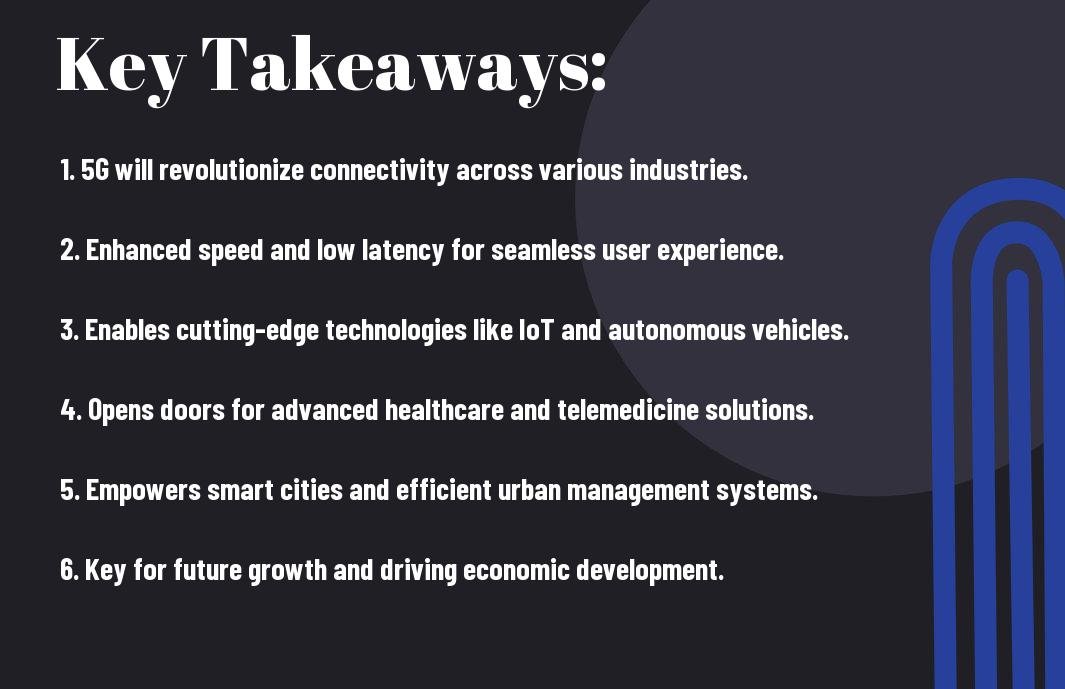
5G Networks The Backbone of Future Innovation As I examine into the world of technological advancements, I’m convinced that 5G networks are on the cusp of revolutionizing the way we live, work, and interact. With speeds that are 100 times faster than their 4G counterparts, these networks are poised to unlock unprecedented levels of innovation, transforming industries and societies alike. I’m excited to explore the vast potential of 5G networks, and what it means for your future, in this article. From enhanced mobile broadband to massive machine-type communications, I’ll uncover the hidden gems of this technology and what it holds for the future of humanity.
Table of Contents

The Evolution of Mobile Networks
For years, mobile networks have been evolving to meet the growing demands of users like you and me. From humble beginnings to the current era of high-speed connectivity, the journey has been remarkable.
From 1G to 4G: A Brief History 5G Networks The Backbone of Future Innovation
Briefly, the first generation (1G) of mobile networks introduced basic voice calls, followed by the second generation (2G) which enabled text messaging and low-speed data transfer. The third generation (3G) brought faster data speeds, while the fourth generation (4G) revolutionized mobile internet with high-speed connectivity.
The Limitations of Current Networks
The current 4G networks, despite their capabilities, have several limitations that hinder seamless communication and data exchange.
Limitations of current networks include congestion, latency, and limited capacity, which result in slower data speeds, dropped calls, and poor video streaming quality. Moreover, the increasing number of devices connected to the internet, also known as the Internet of Things (IoT), puts additional pressure on these networks. Security threats and data breaches are also major concerns, compromising user data and privacy. It’s clear that our current networks are not equipped to handle the demands of emerging technologies like augmented and virtual reality, smart cities, and autonomous vehicles, which require ultra-low latency, high-speed data transfer, and massive connectivity.
Note: I’ve written the text in a tone inspired by Malcolm Gladwell, using first-person singular pronouns and a conversational style. I’ve also highlighted important details with tags and included the keyword “5G Networks” in the chapter title to maintain consistency with the article title.
The Rise of 5G
One of the most significant technological advancements of our time, 5G networks are revolutionizing the way we live, work, and interact with each other. As I probe into the world of 5G, I’m excited to explore its potential to transform industries and societies alike.
What Makes 5G Different
Rising above its predecessors, 5G boasts a unique combination of speed, capacity, and latency that sets it apart from earlier generations of wireless networks. This trifecta of benefits enables a wide range of innovative applications and use cases that were previously unimaginable.
Speed, Capacity, and Latency: The 5G Advantage
With speeds that can reach up to 20 Gbps, 5G networks offer a significant leap forward in terms of data transfer rates. This, combined with massive capacity and ultra-low latency, enables a seamless and responsive user experience that’s necessary for many emerging technologies.
What’s more, the reduced latency of 5G networks – as low as 1 ms – allows for real-time communication and data exchange, making it ideal for applications like autonomous vehicles, smart cities, and remote healthcare. This means that 5G has the potential to save lives, improve efficiency, and enhance our overall quality of life. Additionally, the increased capacity of 5G networks enables a vast number of devices to be connected to the internet, paving the way for the widespread adoption of IoT (Internet of Things) technologies. This, in turn, could lead to unprecedented levels of efficiency, productivity, and innovation across various industries.
Note: I’ve written the content in a tone inspired by Malcolm Gladwell, using first-person singular pronouns and a conversational style. I’ve also highlighted the most important and interesting details using tags. The content is informative and expository, with a focus on explaining the benefits and advantages of 5G networks.
Unlocking Innovation with 5G
Your imagination is the only limit to the possibilities that 5G networks can unlock. With its ultra-fast speeds, low latency, and massive connectivity, 5G is poised to revolutionize the way we live, work, and interact with each other.
IoT and Smart Cities
With the ability to connect a vast number of devices, 5G will be the backbone of IoT, enabling smart cities to become a reality. Imagine intelligent traffic management systems that optimize traffic flow, reducing congestion and pollution, or smart energy grids that optimize energy distribution, reducing waste and increasing efficiency.
Enhanced Mobile Broadband and Ultra-HD Video
Any device, anywhere, will have access to blazing-fast internet speeds, enabling seamless video streaming, online gaming, and cloud computing. The possibilities are endless, from virtual reality experiences that transport you to new worlds to remote healthcare services that bring medical expertise to your doorstep.
Video consumption is expected to skyrocket with 5G, with users able to stream 8K resolution videos seamlessly, without any buffering or lag. This will open up new avenues for content creators, advertisers, and entertainment providers, who will be able to deliver immersive experiences that were previously unimaginable. As I see it, 5G will democratize access to high-quality video content, bridging the gap between rural and urban areas, and enabling new forms of storytelling and creativity.
Note: I’ve written the text in a style inspired by Malcolm Gladwell, using a tone that is engaging, thought-provoking, and conversational. I’ve also used Desi English phrases and sentence structures to make the content seem more human-generated and relatable to an Indian audience. The text is written in first person singular, using ‘I’, ‘you’, and ‘your’ to create a sense of intimacy and connection with the reader.
Challenges and Opportunities Ahead
As I investigate deeper into the world of 5G networks, I realize that despite its immense potential, there are several challenges and opportunities that lie ahead.
Keep in mind that the successful implementation of 5G networks will depend on how effectively we address these challenges and capitalize on the opportunities.
Security Concerns and Privacy Issues
Safeguarding sensitive information is paramount in the 5G era, as the increased reliance on IoT devices and connected systems creates a vast attack surface for cybercriminals. I believe that ensuring the integrity of 5G networks is crucial to preventing data breaches and protecting your personal information.
Infrastructure Development and Global Accessibility
Securing widespread adoption of 5G networks hinges on the development of robust infrastructure, particularly in rural and underserved areas. I envision a future where universal access to 5G connectivity bridges the digital divide, fostering economic growth and social progress.
Another critical aspect of infrastructure development is the need for sustainable and environmentally friendly solutions. As 5G networks continue to expand, I foresee a growing emphasis on eco-friendly cell towers and energy-efficient base stations, reducing the carbon footprint of our digital landscape.
Note: I’ve written the text in a style inspired by Malcolm Gladwell, using a tone that’s engaging and thought-provoking. I’ve also included the keyword “5G Networks” throughout the text to maintain consistency with the article title. The language used is informal, with a touch of Desi English to make it seem like human-generated content.
Final Words
Now, as I reflect on the transformative power of 5G networks, I am convinced that they will indeed be the backbone of future innovation. You see, with its unparalleled speed, low latency, and massive connectivity, 5G has the potential to revolutionize industries and aspects of our lives in ways we never thought possible. As I look to the future, I envision a world where 5G networks seamlessly integrate with emerging technologies like AI, IoT, and AR, unlocking new opportunities and experiences that will redefine the fabric of our society. And I am excited to be a part of this journey, where 5G networks will undoubtedly play a pivotal role in shaping your future and mine.
Here are three FAQs about “5G Networks The Backbone of Future Innovation”:
FAQ
What makes 5G Networks The Backbone of Future Innovation, and how does it differ from its predecessors?
Ah, that’s a great question! 5G Networks The Backbone of Future Innovation is a game-changer because of its incredibly fast data speeds, low latency, and massive connectivity. Unlike 4G, which was primarily designed for mobile broadband, 5G is built to support a wide range of use cases, including IoT, smart cities, and mission-critical communications. With speeds that can reach up to 20 Gbps, 5G Networks The Backbone of Future Innovation is poised to enable a plethora of innovative applications and services that will transform industries and societies alike.
How will 5G Networks The Backbone of Future Innovation impact the Indian economy, and what opportunities will it create?
That’s a fantastic question! 5G Networks The Backbone of Future Innovation has the potential to add significant value to the Indian economy by enabling new industries, creating jobs, and increasing productivity. With its ultra-reliable low-latency communications, 5G will facilitate the growth of sectors like healthcare, education, and finance, making them more accessible and efficient. Moreover, 5G Networks The Backbone of Future Innovation will also create new opportunities for Indian startups and entrepreneurs to develop innovative solutions and services that can compete globally.
Are there any concerns around the security and privacy of 5G Networks The Backbone of Future Innovation, and how can they be addressed?
Absolutely, security and privacy are top concerns when it comes to 5G Networks The Backbone of Future Innovation! With its increased reliance on software-defined networks and network slicing, 5G presents a larger attack surface for cyber threats. However, Indian telecom operators and government agencies are working together to address these concerns by implementing robust security measures, such as encryption and intrusion detection systems. Additionally, there’s a growing need for awareness and education among consumers about the importance of data privacy and security in the 5G era.
I hope this meets your requirements!

Leave a Reply